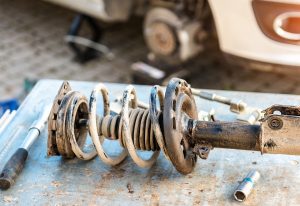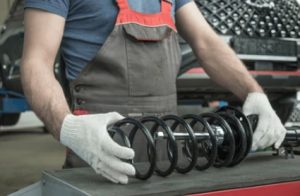Suspension springs are a critical component of your vehicle’s suspension system, responsible for absorbing road shocks, maintaining ride height, and ensuring proper handling. They work together with shock absorbers to keep the tires in contact with the road surface, providing stability, comfort, and control. However, like any other component, springs wear out over time — and one of the biggest factors influencing their lifespan is how you drive.
Your driving style has a direct and significant impact on suspension spring wear. Aggressive driving, overloading, frequent hard braking, or driving over rough roads can all accelerate spring fatigue and lead to premature failure. Understanding how different driving behaviors affect suspension performance is essential for extending the life of your springs and ensuring vehicle safety.
Why Suspension Springs Wear Out

Springs are designed to flex repeatedly as the suspension compresses and rebounds. Over time, this continuous stress leads to metal fatigue — the gradual weakening of the spring material. Eventually, springs lose their elasticity, sag, or even break.
While factors like manufacturing quality, road conditions, and climate all play roles, driving habits are among the most influential.
How Driving Style Impacts Spring Wear
Below are the most common driving behaviors that contribute to suspension spring degradation:
1. Aggressive Driving and Hard Cornering
Frequent rapid acceleration, sharp cornering, and hard braking put significant extra stress on suspension springs. When the vehicle weight shifts dramatically during these maneuvers, the springs must absorb greater forces than they were designed for on a regular basis.
-
Impact: Increased fatigue, loss of elasticity, and premature sagging.
-
Result: Vehicle may sit lower than normal, reducing ground clearance and altering suspension geometry.
2. Driving on Rough Roads or Hitting Potholes
Every time your wheels encounter a pothole, speed bump, or uneven road surface, your suspension compresses sharply. Over time, these repeated impacts cause microscopic cracks in the spring steel, eventually leading to weakening or breakage.
-
Impact: Surface damage and accelerated wear due to excessive compression cycles.
-
Result: Reduced spring performance, increased ride harshness, and potential coil breakage.
3. Frequent Overloading
Carrying loads beyond your vehicle’s rated capacity places a constant strain on the suspension. Springs are forced to operate outside their optimal range, remaining compressed for extended periods.
-
Impact: Permanent deformation (sagging) and reduced spring rebound force.
-
Result: Lower ride height, bottoming out, and compromised handling.
4. Sudden Braking and Acceleration
Abrupt stops and starts shift vehicle weight forward and backward quickly. This repeated weight transfer over time adds additional stress to suspension components.
-
Impact: Uneven wear, especially on front springs.
-
Result: Nose-diving during braking and rear-end squat during acceleration.
5. Ignoring Maintenance and Inspections
Even the most cautious driving style can’t compensate for neglect. If worn suspension components like shock absorbers are not replaced in time, springs must work harder to control suspension movement.
-
Impact: Accelerated fatigue due to excessive oscillation.
-
Result: Springs wear out faster and can fail unexpectedly.
Table: Driving Habits and Their Effects on Spring Wear
| Driving Behavior | Effect on Springs | Long-Term Result |
|---|---|---|
| Aggressive cornering | Repeated high load on springs | Sagging, reduced elasticity |
| Driving on rough roads | Excessive compression and rebound cycles | Cracking, coil breakage |
| Frequent overloading | Constant stress and deformation | Lower ride height, premature failure |
| Sudden braking/acceleration | Rapid weight transfer | Uneven wear, handling issues |
| Ignored maintenance | Increased workload on springs | Shortened lifespan, suspension failure |
Signs Your Springs Are Wearing Out
Recognizing early symptoms of spring wear can prevent costly repairs and safety hazards. Watch out for these warning signs:
-
Uneven ride height: One side of the car sits lower than the other.
-
Increased body roll: The vehicle leans excessively during turns.
-
Harsh or bouncy ride: Springs are no longer absorbing road shocks effectively.
-
Clunking noises: A broken coil may be hitting other suspension components.
-
Tire wear issues: Sagging springs can affect alignment, leading to uneven tire wear.
Tips to Extend Suspension Spring Life

While you can’t eliminate wear entirely, you can significantly slow it down by adopting better driving habits and maintenance practices:
-
Drive smoothly: Avoid sudden braking, rapid acceleration, and aggressive cornering.
-
Reduce speed on rough roads: Slow down to minimize compression impacts.
-
Avoid overloading: Follow the manufacturer’s load capacity guidelines.
-
Inspect suspension regularly: Check for sagging, rust, or cracks every 20,000–30,000 km.
-
Replace worn shocks: Healthy dampers reduce spring stress and extend lifespan.
The Future of Suspension Springs
Modern vehicles — especially electric and performance models — are placing new demands on suspension systems. Advanced materials like high-strength steel and progressive-rate springs are being used to improve durability and performance. Adaptive suspension systems that adjust stiffness based on driving conditions are also reducing wear by distributing loads more effectively.
Final Thoughts
Your driving style plays a crucial role in determining how long your suspension springs last. Aggressive maneuvers, overloading, and neglect can significantly shorten their service life, while smooth driving and regular maintenance can extend it by years.
By understanding how your habits impact suspension components, you can take steps to protect your springs, improve ride comfort, and enhance overall vehicle safety.
If you’re noticing signs of wear — or simply want to upgrade your suspension for better performance — you can Buy Springs & Components online and choose high-quality parts tailored to your driving needs.
In summary: Driving style isn’t just about fuel economy or tire wear — it’s a key factor in suspension spring health. Treat your vehicle gently, maintain it regularly, and it will reward you with a smoother, safer, and longer-lasting ride.